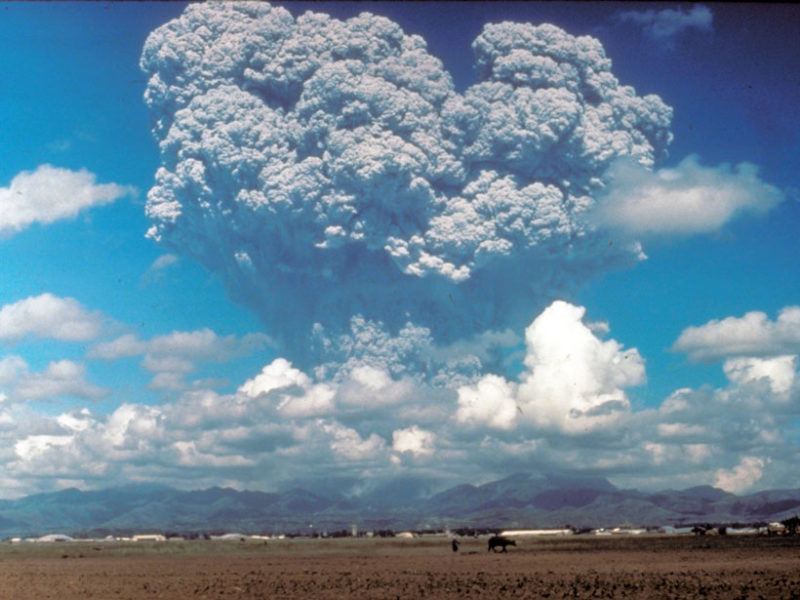
While a major eruption is currently occurring in La Palma, you probably want to know if it will have an influence on the climate. A new science study has shown that the warming of our atmosphere will increase the cooling effect of rare, large eruptions, thus making them even more apocalyptic.
As you already know, volcanic eruptions can have a massive effect on Earth’s climate. Volcanic ash and gases from the 1815 eruption of Mount Tambora, Indonesia, for example, contributed to 1816 being the “year without a summer,” with crop failures and famines across the Northern Hemisphere. In 1991, the eruption of Mount Pinatubo in the Philippines cooled the climate for around 3 years.
Large volcanic eruptions like Tambora and Pinatubo send plumes of ash and gas high into the atmosphere. Sulfate aerosols from these plumes scatter sunlight, reflecting some of it back into space. This scattering warms the stratosphere but cools the troposphere (the lowest layer of Earth’s atmosphere) and Earth’s surface.
Now, a new research has found that our current warming atmosphere could increase the cooling effect of large eruptions like these, which typically occur a couple of times every century. The study also found, however, that the cooling effects of smaller, more frequent eruptions could be reduced dramatically.
“What really matters is whether these volcanic aerosols are injected into the stratosphere—that is, above 16 kilometers in the tropics under current climate conditions and closer to 10 kilometers at high latitudes,” explained Thomas Aubry.
“If aerosols are injected at these altitudes, they can stay in the atmosphere for a couple of years. If they are injected at lower altitudes, they are essentially going to be washed out by precipitation in the troposphere. The climatic effect will only last for a few weeks.”
The power of a volcanic eruption influences the elevation at which gases enter the atmosphere, with stronger eruptions injecting more aerosols into the stratosphere.
The buoyancy of the gases also contributes to the elevation at which they settle in the atmosphere. Warming could affect this buoyancy: As the atmosphere warms, it becomes less dense, increasing the elevation at which aerosols reach neutral buoyancy.
Modeling Mount Pinatubo
Aubry and his colleagues used models of both climate and volcanic plumes to simulate what happens to aerosols emitted by a volcanic eruption in the present climate and how that could change by the end of the century with continued global warming. In their models, all the eruptions occurred at Mount Pinatubo.
They found that for moderate-magnitude eruptions, the height at which sulfate aerosols settle in the atmosphere remained the same in a warmer climate. But the cooling effect of such eruptions was reduced by around 75%.
This discrepancy has less to do with volcanic emissions and more to do with the atmosphere: The height of the stratosphere is predicted to increase with climate change. Aerosols from moderate volcanic eruptions will therefore be more likely to remain in the troposphere and be removed by rain, reducing their potency.
For large eruptions, models indicated that volcanic plumes will rise around 1.5 kilometers higher in the stratosphere in a warmer climate. This change in elevation will result in the aerosols spreading faster around the world. This increase in aerosol spread is mainly due to a predicted acceleration of the Brewer-Dobson circulation, which moves air in the troposphere upward into the stratosphere and then toward the poles.
In addition to enhancing the global cooling effect of the aerosols, the increase in aerosol spread reduces the rate at which the sulfate particles bump into each other and grow. This further increases their cooling effect by allowing them to better reflect sunlight.
“There is a sweet spot in terms of the size of these tiny and shiny particles where they are very efficient at scattering back the sunlight,” explained Anja Schmidt. “It happens to be that in this global warming scenario that we simulated, these particles grow close to the size where they are very efficient in terms of scattering.”
“We find that the radiative forcing (the amount of energy removed from the planet system by the volcanic aerosol) would be 30% larger in the warm climate, compared to the present-day climate,” Aubry said. “Then we suggest that would amplify the surface cooling by 15%.”
The study is interesting because it makes us think about the processes involved between volcanic emissions and climate in a new way. However, the simulations limit their models to eruptions of Mount Pinatubo in the summer. It would be interesting to see whether the conclusions still hold for eruptions at different latitudes and in different seasons.
A changing stratosphere
It is difficult to say whether the amplified cooling from large volcanic eruptions or the decrease in cooling from smaller eruptions will have a net effect on climate.
Schmidt said that current increases in the frequency and intensity of forest fires could also alter the climatic effects of volcanic eruptions because they are affecting the composition of the stratosphere. “There is really a lot of aerosol pollution in the stratosphere, probably on a scale that we’ve never seen before.” [EOS, Cambridge, Nature]
Do you think the current La Palma volcanic eruption will have a big impact on our climate?
Now subscribe to this blog to get more amazing news curated just for you right in your inbox on a daily basis (here an example of our new newsletter).
You can also follow us on Facebook and/ or Twitter. And, by the way you can also make a donation through Paypal. Thank you!
You should really subscribe to QFiles. You will get very interesting information about strange events around the world.













Do you really think all the strange things happening to this planet is natural.Lets all keep an eye on Hurricane Sam that is still underway a long ways from land,and see where it goes.Commie Joe hates Texas and Florida. My bet is Florida is his target this time since Texas has already been froze,flooded,and wind blown.Texas is now being invaded by some of the worst people in the world so now it’s our turn to suffer his ravaging.I’m keeping a close eye on the volcano on La Palma that could wipe Miami off the map.I guess I need a bigger boat!
I don’t think there is cause for alarm yet. We will see soon enough. Seems like people want to stir up fear at every turn these days with fear mongering, and worst case scenario chatter.
The atmosphere is NOT warming…go to electroverse.net and learn the facts.
And realclimatescience.com … both safe sites that show the facts and history!!!
????? I agree.
TOO MANY ADS THAT INTERRUPT THE TEXT FLOW!!!!!!! And this is with AdBlocker on! Please ensure that the ads are in columns on the right or the left, not in the middle of the article. If not, I will quit reading this site.
Check your ad blocker. I had this happen before on a news site. Sometimes if you check the settings you can see if the settings changed, and turn it back to where it was. That’s what I had to do.